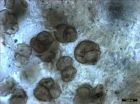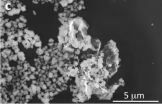(Press-News.org) Remote lochs along the west coast of Scotland are turning up new evidence about the origins of life on land.
A team of scientists exploring rocks around Loch Torridon have discovered the remarkably preserved remains of organisms that once lived on the bottom of ancient lake beds as long as a billion (1000 million) years ago.
These fossils illuminate a key moment in the history of evolution when life made the leap from tiny, simple bacterial (prokaryote) cells towards larger, more complex (eukaryotic) cells which would make photosynthesis and sexual reproduction possible.
The team, from Oxford University, the University of Sheffield and Boston College, report their findings in this week's Nature.
"These new fossils show that the move toward complex algal cells living in lakes on land had started over a billion years ago, much earlier than had been thought," said Professor Martin Brasier of Oxford University's Department of Earth Sciences, an author of the paper.
"These new cells differ from their bacterial ancestors in that they have specialised structures including a nucleus, as well as mitochondria and chloroplasts – which are vital for photosynthesis. They also undergo sexual reproduction, leading to much more rapid rates of evolutionary turnover."
Some of these ancient fossils are so finely ornamented, and so large and complex, that they are evidence for a surprisingly early start for the emergence of complex eukaryote cells on land. The researchers believe that it was from complex cells such as these that green algae and green land plants – everything from lettuce to larch trees – were able to evolve and colonise the land.
Dr Charles Wellman, Reader in Palaeobiology in the Department of Animal and Plant Sciences at the University of Sheffield, an author of the paper, said: "It is generally considered that life originated in the ocean and that the important developments in the early evolution of life took place in the marine environment: the origin of prokaryotes, eukaryotes, sex, multicellularity etc. During this time the continents are often considered to have been essentially barren of life - or at the most with an insignificant microbial biota dominated by cyanobacteria.
"We have discovered evidence for complex life on land from 1 billion year old deposits from Scotland. This suggests that life on land at this time was more abundant and complex than anticipated. It also opens the intriguing possibility that some of the major events in the early history of life may have taken place on land and not entirely within the marine realm."
Professor Brasier said: "It may even be that the sort of conditions found in the ancient lakes around Loch Torridon favoured a key step in this transformation, which involved the incorporation of symbiotic bacteria into the cell to form chloroplasts, rather than this occurring in the sea as usually envisaged."
Around 500 million years after the emergence of these complex cells, the surface of the land was starting to become covered in simple vegetation like lichens, mosses and liverworts, and the first animals were able to take their chance and leave the sea behind. These pioneers were followed by the first fish and ferns, reptiles and conifers, mammals and flowering plants – and, eventually, humans.
Professor Brasier adds: "None of this would have been possible without advances long ago made by these little microbes, now entombed within phosphate from the Torridon lakes. It was arguably these organisms that helped to turn our landscape from a harsh and rocky desert into a green and pleasant place."
INFORMATION:
Loch fossils show life harnessed sun and sex early on
2011-04-14
ELSE PRESS RELEASES FROM THIS DATE:
Experimental treatment for COPD in development
2011-04-14
Researchers at the Johns Hopkins Bloomberg School of Public Health have developed a non-steroid based strategy for improving the lung's innate immune defense and decreasing inflammation that can be a problem for patients with chronic obstructive pulmonary disease (COPD). In a study published in the April 13 edition of the journal Science Translational Medicine, the Johns Hopkins researchers targeted the Nrf2 pathway using sulforaphane, an ingredient that is present in broccoli in a precursor form, to enhance the Nrf2 pathway in the lung that mediates the uptake of bacteria. ...
Rules of the Road for California Motorcyclists
2011-04-14
California's temperate climate, long stretches of highway and sunny days make it a motorcyclist's dream. Riders can take to the streets all year long, feeling the wind in their hair and enjoying the freedom that can only be felt on a bike. Of course, as gas prices and temperatures continue to climb, more and more motorcycles will be on the road. Before summer riding season gets in full swing, though, it is important for California motorcyclists to know the rules of the road, including two laws unique to motorcycles.
What Is Different for Motorcycles Versus Passenger ...
Higher CCSVI prevalence confirmed in MS, but meaning of findings remains unclear
2011-04-14
BUFFALO, N.Y. -- A just released study on the relationship between multiple sclerosis (MS) and chronic cerebral venous insufficiency (CCSVI), a narrowing of the extracranial veins that restricts the normal outflow of blood from the brain, found that CCSVI may be a result of MS, not a cause.
The study, conducted by University at Buffalo researchers, appears in the current issue of Neurology, the journal of the American Academy of Neurology.
Robert Zivadinov, MD, PhD, associate professor of neurology in the UB School of Medicine and Biomedical Sciences and president of ...
Your flaws are my pain
2011-04-14
Today, there is increasing exposure of individuals to a public audience. Television shows and the internet provide platforms for this and, at times, allow observing others' flaws and norm transgressions. Regardless of whether the person observed realizes their flaw or not, observers in the audience experience vicarious embarrassment.
For the first time, such vicarious embarrassment experiences as well as their neural basis have been investigated in research published in the open-access, peer-reviewed journal PLoS ONE. The research was led by Sören Krach and Frieder M. ...
Study: To students, music piracy and shoplifting are worlds apart
2011-04-14
What's the difference between stealing a CD from a music store and ripping off music online? The music industry and law enforcers say that there is none: Theft is theft, whether it's physical or digital.
College students participating in a newly published study, however, said that while they were unlikely to shoplift and viewed that behavior as immoral, they were not exactly motivated to follow the laws governing digital music piracy -- a finding that underscores the difficulties of enforcing such laws and to find new ways to discourage the theft of all types of digital ...
New fracture resistance mechanisms provided by graphene
2011-04-14
TUCSON, Ariz. and TROY, N.Y. (April 13, 2011) -- A team of researchers from the University of Arizona and Rensselaer Polytechnic Institute have increased the toughness of ceramic composites by using graphene reinforcements that enable new fracture resistance mechanisms in the ceramic.
The research, lead by Assistant Professor Erica L. Corral from the Materials Science and Engineering Department at the University of Arizona in Tucson, and Professor Nikhil Koratkar from the Department of Mechanical, Aerospace and Nuclear Engineering at Rensselaer Polytechnic Institute ...
Sharing the Road -- Lane Sharing and Lane Splitting in Southern California
2011-04-14
Considering the long expanses of picturesque roads and highways in Southern California, it's no surprise that California streets, roads and highways beckon to motorcyclists and their passengers. But the same roads and highways can be gruelish during heavy traffic.
To get through traffic jams more quickly, some motorcyclists lane share -- that is, they use the same lane as cars and trucks that are stopped in traffic. Others bikers sometimes resort to lane splitting -- driving between traffic lanes to pass stopped vehicles.
Lane splitting and lane sharing by bikers ...
Supreme Court Okays Retaliation Suit by Close Relations under Title VII
2011-04-14
The U.S. Supreme Court recently reinstated a retaliation case where a woman's fiance was fired after she had filed a discrimination claim with the EEOC. The Court had to decide if the firing was retaliation and if the fiance was permitted to file a case under Title VII. The Justices answered yes to both questions.
The Retaliation Claim
The Supreme Court had to analyze the facts to determine if the firing was, in fact, retaliation.
The Court described the facts as follows: "Until 2003, both petitioner Eric Thompson and his fiancee, Miriam Regalado, were employees ...
Queen's researchers pioneer needle-free test for premature babies
2011-04-14
Scientists at Queen's University Belfast have pioneered a new needle-free test to take the sting out of medicine testing in premature babies. The research will not only lead to greater accuracy in prescribing, but will also significantly reduce the trauma of such tests for newborn infants and their families.
In the first published research project worldwide on this new approach to testing medicines in children, the findings were announced in leading US medical journal Pediatrics.
The study, which involves the use of blood spots obtained from a simple heel-prick, took ...
Experts at Experimental Biology examine dietary cholesterol, egg intake and heart disease risk
2011-04-14
Park Ridge, IL (April 13, 2011) – This week at Experimental Biology (EB) 2011 in Washington, D.C., long-standing beliefs about dietary cholesterol intake and cardiovascular disease risk were examined as part of a scientific symposium and a variety of poster presentations. Experts from leading institutions discussed existing and emerging science regarding dietary cholesterol intake and its association with heart disease risk, dispelling some commonly heard myths.
Established research has shown that saturated fat intake may be more likely to raise a person's blood cholesterol ...

